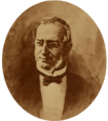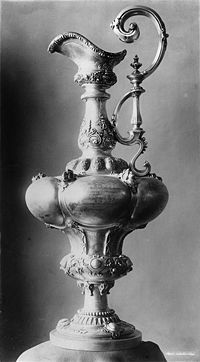Yves GARY Hits: 5035
Category: 1870 : CHALLENGE N°1
 |
 |
 |
When Commodore John C. Stevens returned to this country from England in September, 1851, he brought with him the cup won by the America on the 22nd of August from the fleet of the Royal Yacht Squadron. It was the property of Commodore Stevens and his fellow-owners in the America — Edwin A. Stevens, George L. Schuyler, Hamilton A. Wilkes, J. Beekman Finlay, and Col. James A. Hamilton.
It may be imagined with what pride the owners of the cup displayed it to their friends on the occasion of the dinner tendered Mr. Stevens and his associates at the Astor House on his return.
 The trophy is twenty-seven inches high, thirty-six inches circumference of body and twenty-four inches of base, and weighs one hundred and thirty-four ounces. It is not a cup, properly speaking, but a cylindrical vessel open at both ends, and incapable of holding liquids. It was made in 1851 to the order of the Royal Yacht Squadron by Messrs. R. & S. Gerard, Panton Street, London, and bears the makers' stamp, as well as the English hallmark. All its shields and scrolls are now filled with inscriptions, one dedicating the cup to the America, and twelve for the various matches sailed for it, or thirteen in all. A curious feature of the inscription recording the first race is that the name of Aurora, which vessel was second in the race, does not appear on the cup (making it literally true, in the record, at least, that "there is no second"), while the names of vessels defeated in this race, as given on the cup, number thirteen.
The trophy is twenty-seven inches high, thirty-six inches circumference of body and twenty-four inches of base, and weighs one hundred and thirty-four ounces. It is not a cup, properly speaking, but a cylindrical vessel open at both ends, and incapable of holding liquids. It was made in 1851 to the order of the Royal Yacht Squadron by Messrs. R. & S. Gerard, Panton Street, London, and bears the makers' stamp, as well as the English hallmark. All its shields and scrolls are now filled with inscriptions, one dedicating the cup to the America, and twelve for the various matches sailed for it, or thirteen in all. A curious feature of the inscription recording the first race is that the name of Aurora, which vessel was second in the race, does not appear on the cup (making it literally true, in the record, at least, that "there is no second"), while the names of vessels defeated in this race, as given on the cup, number thirteen.
The cup originally being the property of the winners, each one of the five felt a sense of ownership in it, and it was frequently displayed on their dinner-tables, on occasions of social gatherings, being kept first in the house of one, and then of another. At one time the owners thought of having the cup melted, so that each one of them could have a medal made from the silver in it, properly stamped or engraved with date and inscription commemorative of the race in which the cup was won, each medal to be kept as an heirloom in the family in which it was held, and preserved in a frame or velvet-lined box. Mr. Philip Schuyler, son of George L. Schuyler and grandson of Col. James A. Hamilton, is authority for this interesting statement. This idea died a natural death.
Some of the original five owners died, and the cup remained in the possession of the survivors until the thought took shape in the brain of George L. Schuyler that it should be made an international trophy. The other surviving owners agreed with Mr. Schuyler that this be done, and the cup was conveyed to the keeping of the New York Yacht Club, on July 8th, 1857, under the following conditions, which constitute what is commonly known as the "original deed of gift":
The New York Yacht Club, after accepting the cup, sent notice to all foreign clubs, under date of July 21st, 1857, of their assumption of the trust, and inviting "spirited contest for the championship," promising all challengers "a liberal, hearty welcome, and the strictest fair play."
